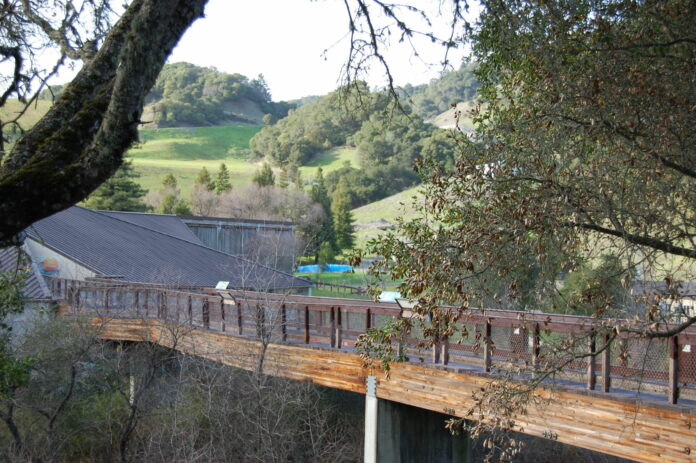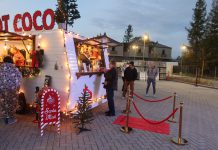
NOT SO RICKETY — The pedestrian bridge at the Warm Springs Dam is structurally sound, according to the Army Corp of Engineers.
The pedestrian bridge at the Warm Springs Dam at the Lake Sonoma Visitor’s Center and hatchery is a heavily trafficked and popular place for folks who want to take in the sites or get a glimpse of fish, and while the old bridge seems to have a sag, the U.S. Army Corps of Engineers San Francisco Division says the bridge is sound.
The infrastructure of the bridge, which connects the visitor’s center to the hatchery viewing area, was called to concern in a Facebook post in the “What’s Happening Healdsburg” group. The post expressed concern about the sag and questioned whether the bridge was safe, especially ahead of the annual Steelhead Festival in February, which brings a lot of visitors to Lake Sonoma and the hatchery.
“We recognize the fact there is some visible deformation on one side of the bridge, and the public concern it has drawn. Given this, we have increased our routine monitoring to ensure there remains no risk to public safety. Naturally, the information from the planned inspection and our monitoring will inform any operational changes and future action,” said Nick Malasavage, chief of the operations and readiness division for the U.S. Army Corps of Engineers San Francisco district.
When asked if the bridge was identified as a concern, Malasavage said it was not identified as a concern.
“The bridge is completely safe based on formal inspections,” Malasavage said.
He said in the last inspection formal report, the wood beams in the bridge were checked for wood rot and “nothing was found.”
“The last inspection report was completed in 2016,” Malasavage said. “The inspection included cores of the main structural wooden beams supporting the walkway, which were in good condition, along with other key components such as metal bracing and concrete piers.”
The next regular inspection takes place later this fiscal year. He said the bridge has a lot of public and staff traffic, so they like to keep an eye on it.
Inspections usually take the form of inspecting beams and other stress points.
“For this bridge we look at the glulam beams, which is an engineered and manufactured beam,” he said.
An engineer also uses a forestry tool to poke a hole in the beam and look inside it to inspect it. They also check the load stress and focus on points of connection where wood meets metal and steal.
“We look at a number of things, like whether something has sat in the sun, or been in the water,” he said.
At the end of the report there is an A, B, C, D, E and F rating.
“The last inspection report (for the bridge) was an A or a B,” Malasavage said. “We have a formal and informal cycle of inspections and the sag has been there for years and we haven’t discovered any condition that would make the bridge hazardous to the public or staff. There is no condition that compels us to close off traffic to the bridge.”
He said both the visitor’s center and the bridge are around 40 years old and were both built in the 1980s when the dam was being constructed.
What is the lifetime of a structure such as a pedestrian bridge?
“That is the million-dollar question for an engineer,” Malasavage said. He said the lifespan is about 50 years.
When it comes time to replace or repair the bridge, Malasavage said a proposal would be penned and submitted to the federal budget system to determine if they could secure funds for a project.
The U.S. Army Corps of Engineers also works with the Friends of Lake Sonoma. The group often helps with small projects as well as donating volunteer time.
“They replaced the small pedestrian deck on the other side of the hatchery. They are a great partner,” Malasavage said.







